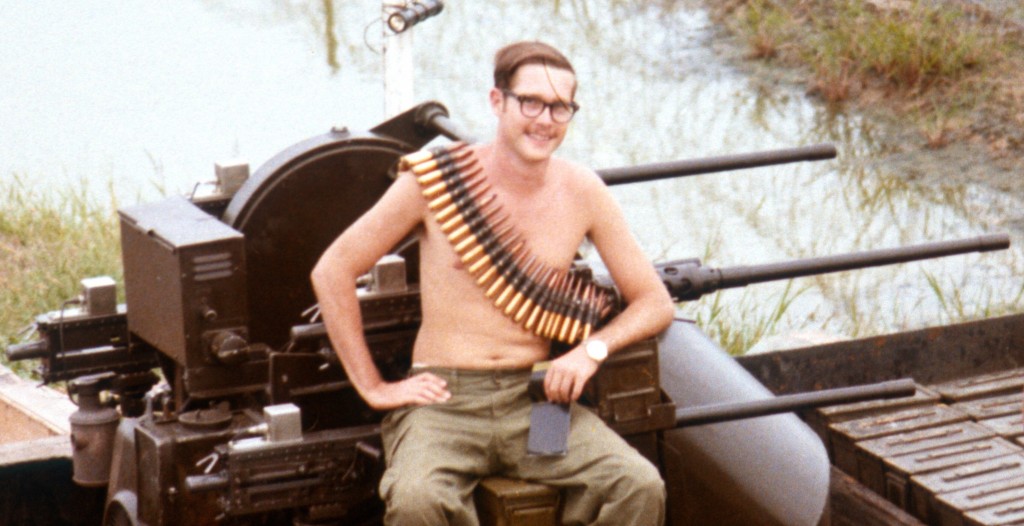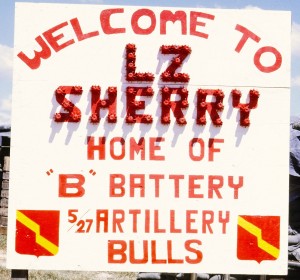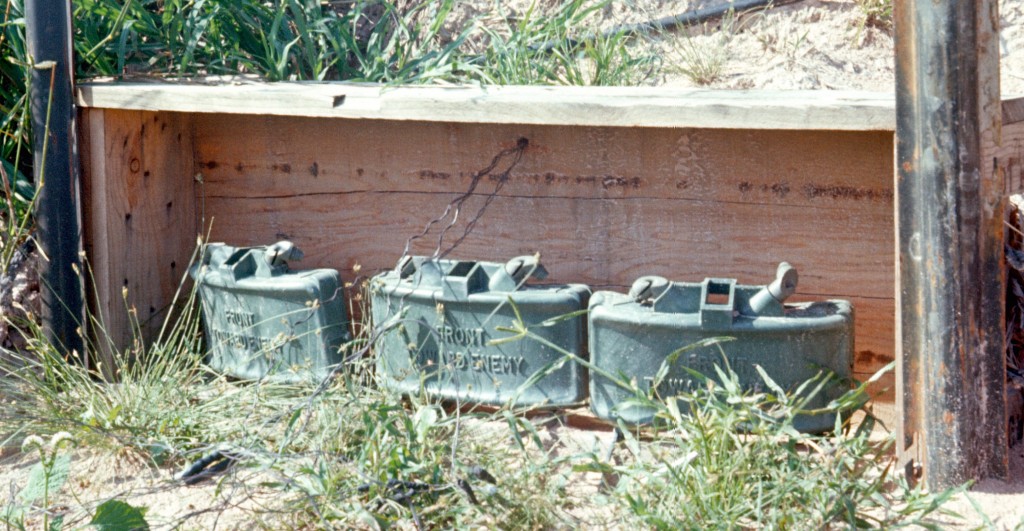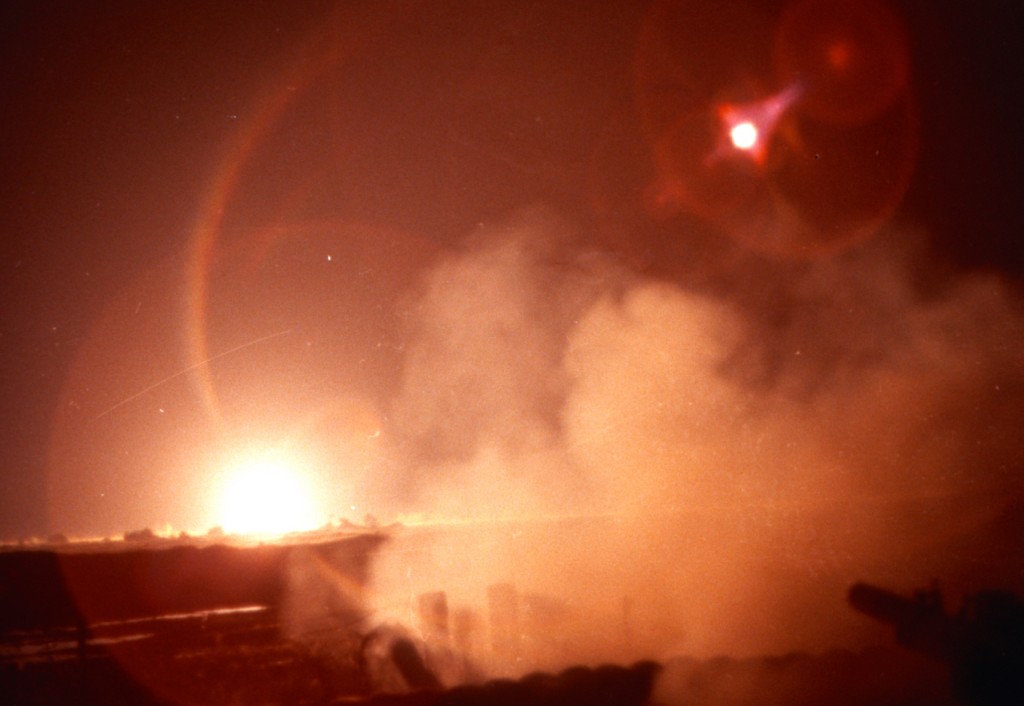
Jim went to Vietnam in December 1969 as a Quad-50 squad leader after completing non-commissioned officer training at Ft. Bliss, Texas.
The first part of my tour in Vietnam I was stationed out of Artillery Hill near Pleiku (300 miles north of LZ Sherry). We were on the road six days a week: Kontum, Dak To, Ben Het, LZ Hard Times, LZ Blackhawk and Pump Station Eight. We escorted a bunch of infantry guys over to the Cambodian border in May, and right after that I went to LZ Sherry.
On May 1, 1970 U.S. forces joined South Vietnam units which days earlier had crossed into Cambodia to attack approximately 40,000 Viet Cong in safe haven just over the Cambodian border.
The first thing I saw getting off the helicopter at Sherry was that sign that said WELCOME TO LZ SHERRY. It was spelled out with mortar tailfins, and they were not our tailfins. I always liked that sign.

It reminded me that a few weeks before I got there one of our guys was killed on the other Quad-50. (There were two Quad-50s at Sherry. Jim’s was on the south perimeter. The other was on the west perimeter where Charles Cordle was killed.) He was hit with a mortar round. I think it was the first mortar round that hit. It landed damn near on top of him.
“Fire power for hire” is what we were. We were supposed to have rounds in the air before anybody else. That’s the way we were trained: first to fire and last to leave. When it started getting dark it was flack jackets and steel pot helmets. We had better flack jackets than the other guys in the battery, with those big ceramic tiles. We were exposed, so we had those great big heavy-ass flack jackets.
At Pleiku I was always on the road and I lived in some pretty primitive conditions, so to get to Sherry and have a permanent bunker was kind of nice. I liked a lot of things about Sherry, most of all the free fire at night (firing at will within a given sector). Everywhere else I had been, the hardest thing to get was clearance to fire. If we could get clearance to fire the enemy didn’t want to mess with us. But if we didn’t get clearance, we’d get messed with. At them other places it took an act of Congress to get permission to fire. At Sherry we were encouraged to fire.
And Sherry was the first LZ I was ever on where they had a great setup of Claymores mines (command detonated anti-personnel mines scattered throughout the perimeter wire). They were already set up when I got there.

We pulled the blasting caps out of them every morning. I always took the last guard duty at night so that I could reserve that job for myself and make sure the wires were still good on the blasting caps. Then I’d go to breakfast. In the evenings after dinner I would go back out and hook the mines back up myself. There was a wooden box at our guard station with a strip that had all the wires coming from the Claymores. You had another wire with a battery connection that let you fire one Claymore at a time, or just run it across and blow the whole perimeter in case the world was coming to an end.
Want Eggs With Those Shells?
One night a radar guy pulled guard duty with me because their equipment was down and the radar guys were on loan to us. He was – and I don’t mean this in a negative fashion – he was kind of a computer geek and didn’t carry a weapon. He was a technical guy and a nice guy, super nice. After unhooking the Claymore mines in the morning we went into the mess hall. We were the very first ones there.
The mess daddy was a Spec 5 or 6 named Chaves. He never got along with anybody. Chaves always cleaned the grills in the mornings. He would just throw some eggs on there, shells and all, beat ‘em up and wipe the grill up with that, and then start cooking.
My radar guy had never been there early in the morning before. We walk in and Chaves takes one look at this guy and says, “How you want ‘em? How you want your eggs?”
The guy says, “How about scrambled.”
Chaves says, “You got ‘em.” He grabs two eggs, throws ‘them down on the grill shells and all, takes his little beater, wipes them around two or three times till they’re done, puts them on the spatula and pokes them out to the guy. The guy didn’t know what to do. He finally puts his plate out like he’s gonna take them, and Chaves just dies laughing. You had to be there to appreciate it, because Chaves was not a real friendly guy and he fit the part good. That was probably my favorite experience at Sherry, just to be a bystander.
Saved By Kool-Aid
Memories of Vietnam are often a slurry of half-facts and twisted timelines. The incidents veterans remember – in fine detail – are the trivial decisions that saved them from a tragedy, but laid it on another.
We have veteran reunions and when we get together it takes three of us to remember a story, and four of us to remember a name. But I’ll always remember this.
Sherry was the smallest fire base I was ever on, so small the chopper pad and the dump were both outside the wire. And we had to get our water for showers from a well outside the wire. We were supposed to go get water one day and Lem Cox off the Dusters and I were settin’ in the mess hall together drinking orange Kool-Aid. Two of Lem’s crew, Jackson and a guy nicknamed Fluffy, came in and said, “Y’all want to go with us?”
We kidded them and said, “Na. We’re gonna sit here and drink a few more pitchers of beer.” On that water run these guys hit a mine. They medevac’d both of them out and they never came back.
A Permanent Scar
The water at Sherry was so dang nasty it was hard to drink, so when you could you drank beer. Each gun was allowed a case of beer a day. It was Black Label or Falstaff typically. So during the day if we were not on duty, we’d have a hot Black Label or a hot Falstaff, and it would spew out when you popped the tab. Ever since I put ice in everything. A year without ice left a permanent scar on me.
Nights Of Death And Beauty
When it was quiet at night I’d sit up on the gun watching whippoorwills and owls land on the wire looking for rodents. I’d take my M-16 and I’d pick them off. Then in the morning when I unhooked the mines I’d gather them up and take pictures of me with the owl or whippoorwill. (None of these big game photos survive.)
My Quad shot south. I could see LZ Betty’s lights at night (sister firebase five miles to the south outside Phan Thiet). I could look the other way over the Duster behind me on the far perimeter and see LZ Sandy (the other sister battery to the north). I had a good friend on a Duster there, we were in school together at Ft. Bliss. We’d talk on the radio and he would tell me when they were going to practice fire. Every round was a tracer and they would fire high in the air.
Or sometimes fire direction control would call me at night and tell me when they were going to shoot a Willie Peter (white phosphorous: an incendiary howitzer round that could ignite cloth, fuel, ammunition and other combustibles, and sometimes shot as an airburst over enemy soldiers). We would close our eyes when we heard the howitzer go off, so when the round popped it was not like someone jumped up and took a flash photo in your face. They would pop right in front of me. You closed your eyes, then when you heard it bust you could open and enjoy the beauty of it.

Skilled, Tough, Ready Around the Clock
Mitch Reynolds was the lone Quad-50 mechanic for the battalion, traveling across its 25,000 square mile area of operations to repair aging equipment. He remembers Jim Logan fondly.
What do I remember about LZ Sherry? The dust, the sand, the road that ran to Phan Thiet being heavily mined and you had to sweep it all the time. Lots of mortar fire, a lot of incoming and lot of outgoing. Illumination flares all night long.
I liked going to Sherry because I liked Jim Logan. He was a nice guy. A gentleman with a great sense of humor. More than anything he was a strict military person; he wanted everything the military way because our lives depended on the guns being right and things being correct.
After working on the Quads I would stay for a couple days to make sure they worked right, and I’d pull guard duty at night with the crews. The other Quad-50 crew at Sherry was kind of loose. They had a better guard tower, but they were a little loosey-goosey. Jim and his guys were STRAC.
Later in life Mitch renewed the friendship with Jim and was able to talk with him before he died.